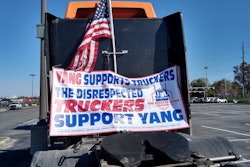
… slow down federal encouragement of / funding for autonomous vehicle research . That is, at least, the point of view offered in this column by Paul Harasim of the Las Vegas Review Journal. Published last month, Harasim’s argument drew heavily on an interview with Texas-based trucker Jerry Jackson, and came amid reports about the increasing speed at which vehicle automation seems to be coming. The disconnect between truckers’ expected timeline for such technology’s commercial viability and the view of tech wizards in Silicon Valley and elsewhere made National Public Radio in October. (The online version was headed up by a picture of one of the retrofit Otto Volvos.) Our blogger Wendy Parker referenced another report about said disconnect, published more recently at the Quartz website.
More recently, this report about similar disconnects in other sectors showed one Silicon Valley company experimenting with a Universal Basic Income (UBI is Social Security for all, all the time, essentially) concept to test the feasibility of such given the displacement of work opportunities of a variety of kinds that technological automation could result (and is resulting, in some cases) in. The key concern: “What if we’re entering an automated future where there won’t be enough jobs for the people who need them? If this happens, how will people pay for food and shelter?” asked reporter Queena Kim.
In Kim’s report, the pilot project of sorts in UBI is detailed as the brainchild of “tech accelerator” Y Combinator, which will for a time deliver a guaranteed sum to a certain number of residents and track what happens in their lives following.
Another test of such a system — in this case for unemployed workers and packaged as welfare reform of a sort — is in place in Finland. It’s also under discussion in left-of-center circles in the United States and around the world. The central tension (whether technological progress will ultimately create as many or more work opportunities than it will displace, or not) we’ve hit on in past reporting on the increasing automation truckers can expect as heavy vehicles develop over the next decades.
To date, the Department of Transportation has more or less encouraged vehicle automation. Note a recent model guidance situated around the regulatory framework for manufacturers of so-called “highly automated vehicles” (HAVs). It expressed an explicit purpose to “speed the delivery of an initial regulatory framework and best practices to guide manufacturers and other entities in the safe design, development, testing, and deployment of” such vehicles.
A regulatory framework around the testing and certification of the safety of such vehicles can certainly be seen as a good thing for those who will ultimately be sharing the road with them (see the issues with Tesla’s Autopilot function from last year for some evidence for that). Yet it could also create the conditions that indeed speed automation’s arrival to the mainstream of transportation. For what it’s worth, what DOT’s hopeful of, ultimately, they say: better safety to come along with greater automation in driving tasks.








